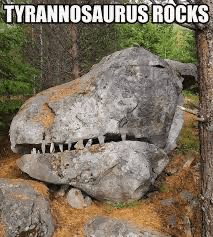These rocks form by the cooling and crystallization of magma or lava.
What are igneous rocks?
Molten rock that is above the Earth’s surface, where the pressure on the dissolved gasses are released.
What is lava?
Loose mineral grains from broken down pre-existing rocks or hard shells.
What are sediments?
The process of squeezing mineral grains closer to each other in sediments, leading to a reduction in the amount of pore space.
What is compaction?
Sedimentary rocks formed directly from substances dissolved in water, either with or without the aid of living organisms.
What are chemical sedimentary rocks?
The majority of the Earth’s crust made of this type of rock.
What is igneous rock?
A spongy material containing partially-transformed pieces of plants.
What is peat?
This type of rock forms by the compaction and cementation of sediments.
What are sedimentary rocks?
Molten rock below Earth’s surface which contains significant amounts of dissolved gasses.
What is magma?
The removal of weathered materials from a place by agents such as water, wind or ice.
What is erosion?
The process of forming a cement that holds mineral grains together in a clastic sedimentary rock.
What is cementation?
Metamorphism that occurs as a result of high pressure, and heat deep in the crust beneath mountain ranges as they form.
What is regional metamorphism?
Fossiliferous limestone composed almost entirely of fossil shell fragments.
What is coquina?
A fossil fuel composed mainly of methane. Used in homes for heating appliances. Plentiful and easy to transport.
What is natural gas?
These rocks form by the application of heat and pressure on pre-existing rocks.
What are metamorphic rocks?
The three types of magma.
What are mafic, flesic, and intermediate?
A mineral or rock fragment eroded from previously existing rocks.
What is a class?
These are the most common cements found in sedimentary rocks.
What are calcite and silica?
High temperature metamorphism of rocks due to the intrusion of magma.
What is contact metamorphism?
These are the two steps in identifying igneous rocks.
What is:
Identify the texture as coarse grain or fine grain
Identify the type of magma
a.k.a. crude oil or just oil. A liquid fossil fuel composed of a wide variety of hydrocarbon molecules.
What is petroleum?
The type of rock shown in the image below.

What is Dwayne the Rock Johnson?
Igneous rocks formed on the Earth’s crust (might be underwater).
What are extrusive igneous rocks?
The breakdown of rocks to form sediments through chemical and physical processes that loosen and change the grains in a rock.
What is weathering?
The response to this image:

What is "how clever?"
A rock formed by the evaporation of seawater, known as halite.
What is rock salt?
Limestone containing numerous fossils are called _______.
What is fossiliferous limestone?
An organic sedimentary rock formed by the compaction and hardening of decayed plant material.
What is coal?
When sand grains become cemented together the resulting rock is_________.
What is sandstone?
Igneous rocks formed beneath the Earth’s crust.
What are intrusive igneous rocks?
Occurs when sediments are no longer transported and are laid down in a place such as a river mouth or beach.
What is deposition?
Composed of grains of gravel that are larger than 2 mm, but may be larger.
What is a conglomerate?
The alignment of mineral grains to create new layers.
What is foliation?
This is what coal becomes when it metamorphosed.
What is anthracite?
The three requirements for the accumulation of petroleum and natural gas.
What are
Source Rock
Reservoir Rock
Trap